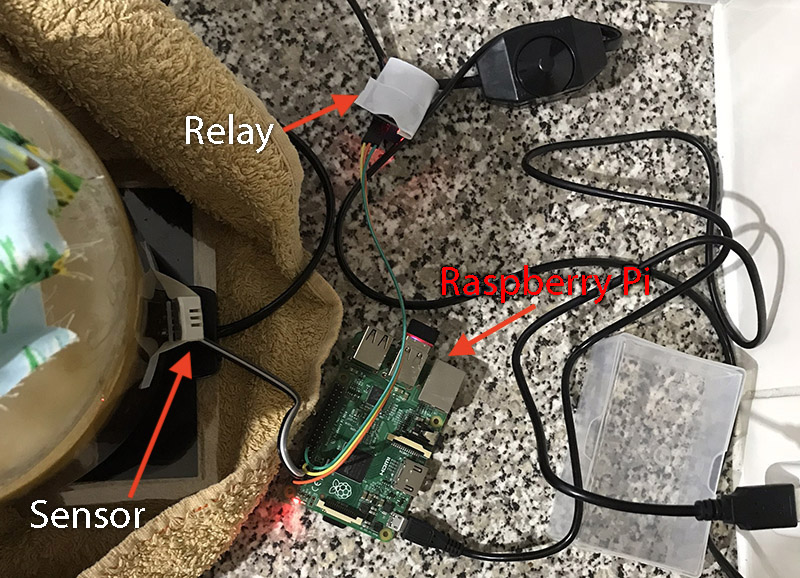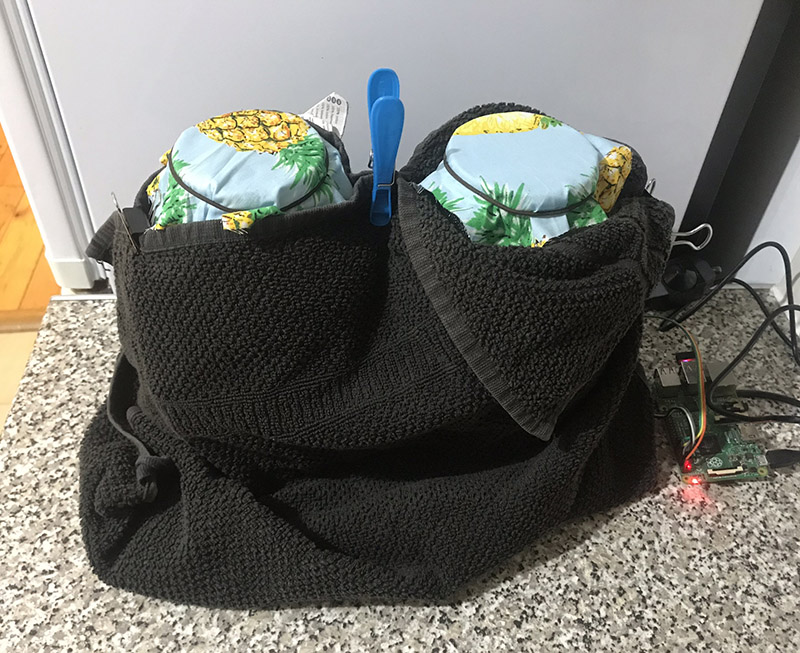Easy way to control kombucha brew temperature
Kombucha can brew in temperatures ranging 10C-42C (50F-108F) but these are extremes. The ideal temperature that gives:
- Good fermentation time
- Good bacteria-yeas ratio
- Nice flavour (caused by first 2)
is considered to be 24.5C-25.5C (76F-78F).
If this temperature is hard to achieve - then strive to keep your kombucha at 20C-29C (69F-84F). This will give you a different taste and different brewing time, but it may be that that’s what you’re looking for. More info on temperatures here.
Next I’ll describe how you can achieve these temperatures in home conditions.
Constant temperature range
Easy and expensive: Heating pad + thermostat
An easy way to achieve a stable temperature range is to use a heating pad and a thermostat.
You shouldn’t put the temperature sensor in the liquid as kombucha can get quite acidic and can corode the sensor. You can place your jar(s) on the pad, and attach the thermostat to one jar.
Because of that you’ll have to check what’s the difference between the inner (liquid temperature) and what thermostat senses. Most probably the sensor will be 1-2 degrees celsius (2-4 Fahrenheit) cooler (as it’s outside the jar) so you’ll want to set your thermostat a bit lower (e.g. set it to 23 degrees Celsius if you want to achieve 25 degrees). Check below section on how to do that.
Moderate difficulty + cheap: Adjustable Heating Pad
If you get a heating pad with adjustable power - then you can get away without having a thermostat.
The trick is to find the right setting that will heat your kombucha just right and keep a steady temperature. To do that follow the steps from measuring temperature difference but use a thermometer to measure water’s temperature. Iterate until you find perfect settings for your desired temperature.
For example if you want to get your kombucha to 25 degrees Celsius (77F) then:
- Fill your jar with water, put it on the pad and set pad’s power to half. Optionally insulate your jars
- After 12/24 hours - measure water’s temperature.
- If temperature is too low (e.g. 23C/73F) then increase the power a bit
- If temperature it too high (e.g. 28C/82F) then decrease the power a bit
- Repeat step 2 until you get somehow close to the desired temperature. After each temperature adjustment you don’t have to wait a full 24 hours, you should be fine by waiting for just few hours

Heating pad + thermostat: Complicated and expensive
If you have a ReaspberryPI, a relay and a temperature sensor - then you can build your own thermostat.
I used AM2302 (wired DHT22) sensor for temperature which was attached to the jar. The code that was controlling it had a range of temperatures (23 and 24 degrees Celsius):
- When the temperature is bellow the range - the relay turns on the heater.
- When the temperature is above the range - the relay turns off the heater.
This way the heater doesn’t turn on and off in quick episodes, but has rather continuous working periods.

Extras
Measuring temperature difference between sensor and pad
If you attached the thermostat sensor to the outer jar wall, then the thermostat will probably read a lower temperature than what’s actually inside the jar. If you want to find out what’s the temperature difference then:
- Fill your jar with water. Don’t use your scoby for the test as you can over-heat it
- Place the jar on the heating pad
- Connect the heating pad through thermostat
- Attach thermostat’s sentor to the jar
- Set thermostat temperature to 23C/73F
- Consider insulating your jar
- Let it work for 24 hours
- After 24 hours - note down what temperature your thermostat is showing
- Place the thermostat sensor into the water and measure water temperature (wait for 1-2 minutes)
- Now calculate the temperature difference by substracting first measurement value from second measurement value
For example if after 24 hours your thermostat is showing 22.7 degrees, and the water temperature is 25.8, then it means that the temperature difference is 3.1 degrees. This will allow you to control more precisely kombucha’s temperature.
Insulating your jars
In order to achieve a more stable temperature of your kombucha and use less power - consider insulating your jars.
An easy way of doing so is by wrapping the jar in a towel (or any other thick and non-flamable material).
By insulating 2 jars I was able to:
- use a 7 watt heating pad for 4 liters (1 gallon) of liquid
- have the heating pad running at less than half capacity
- keep kombucha at a stable temperature of 25C/77F (where room temperature is 20C/68F)
Electricity cost for it is around £4 a year.

How to brew kombucha
This is a really nice illustration by Foolish Fire on how to brew kombucha:
